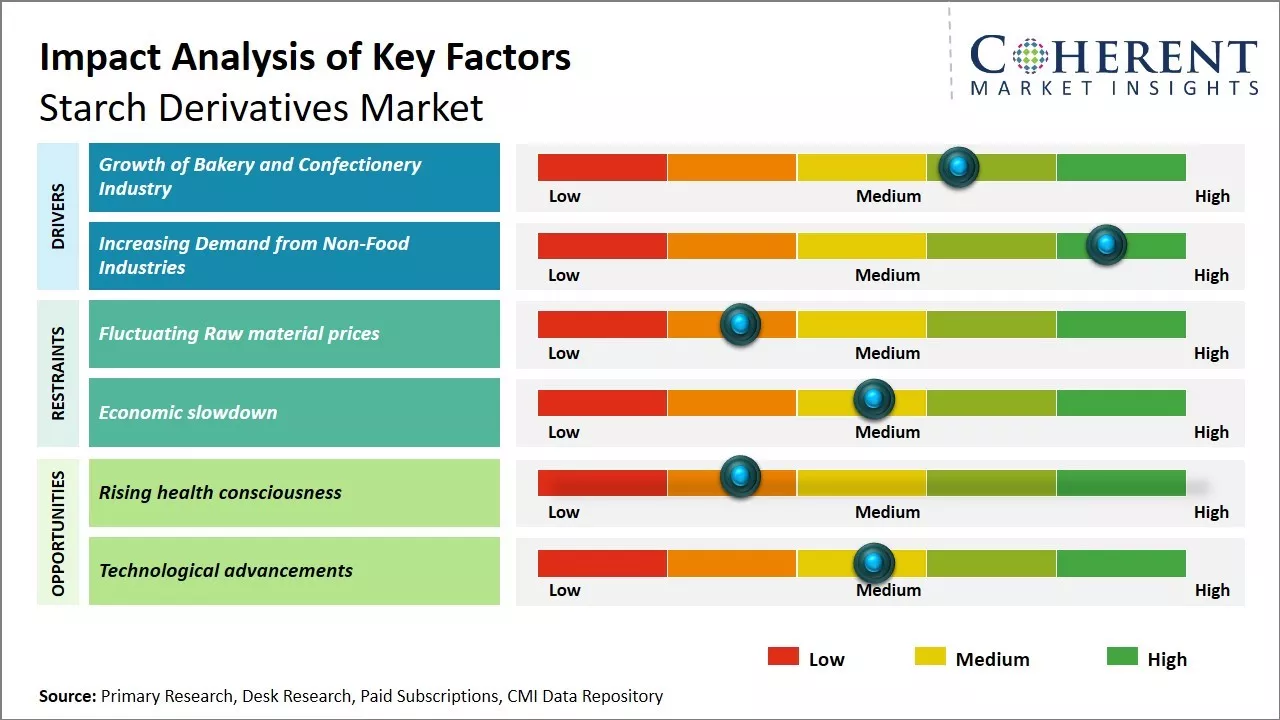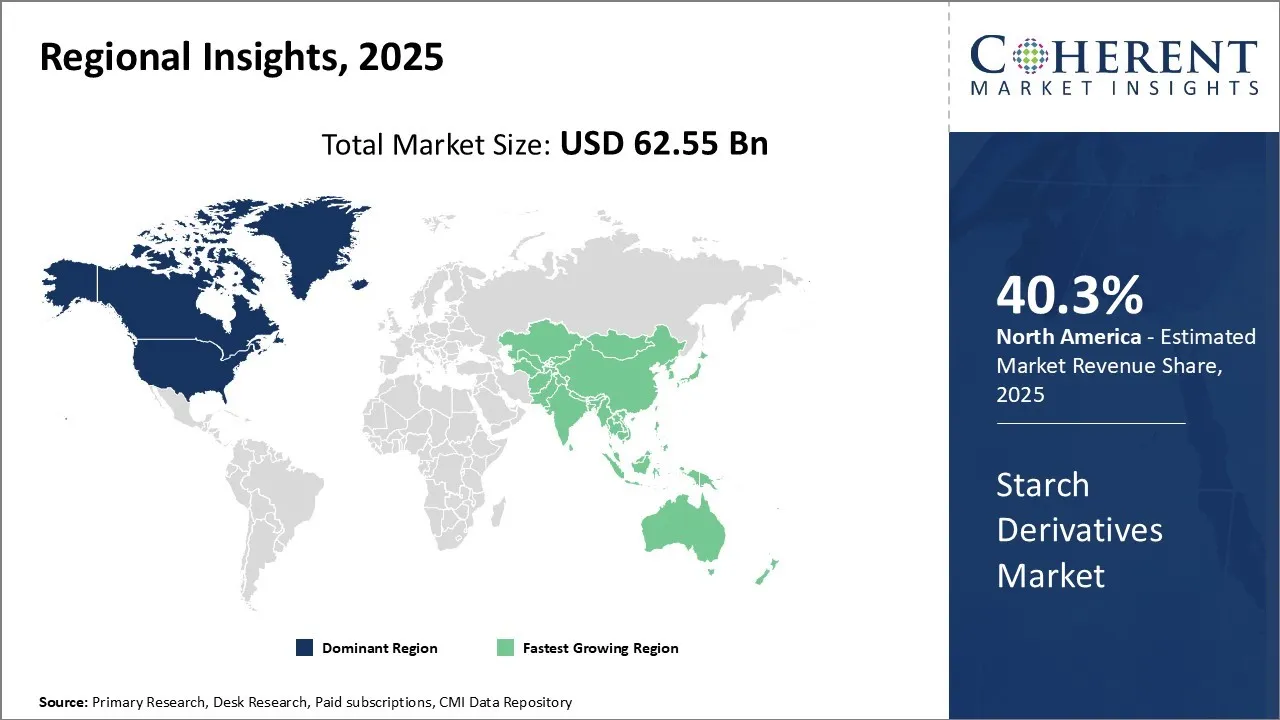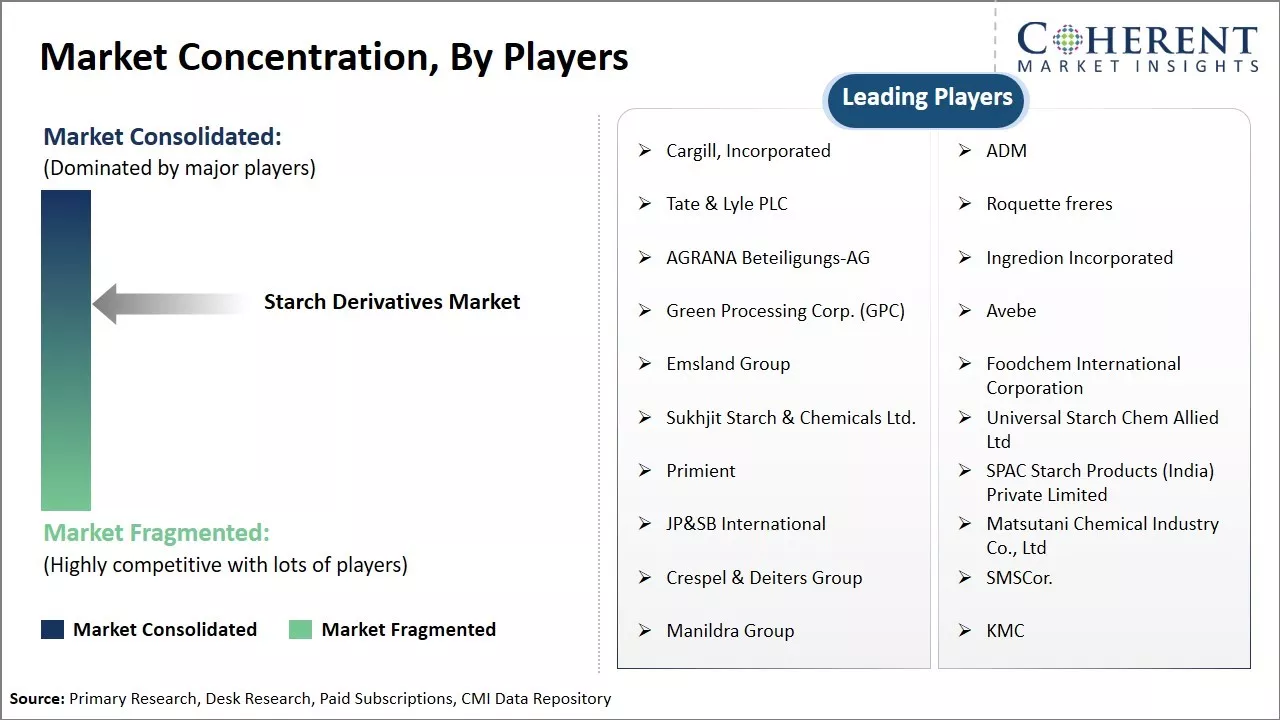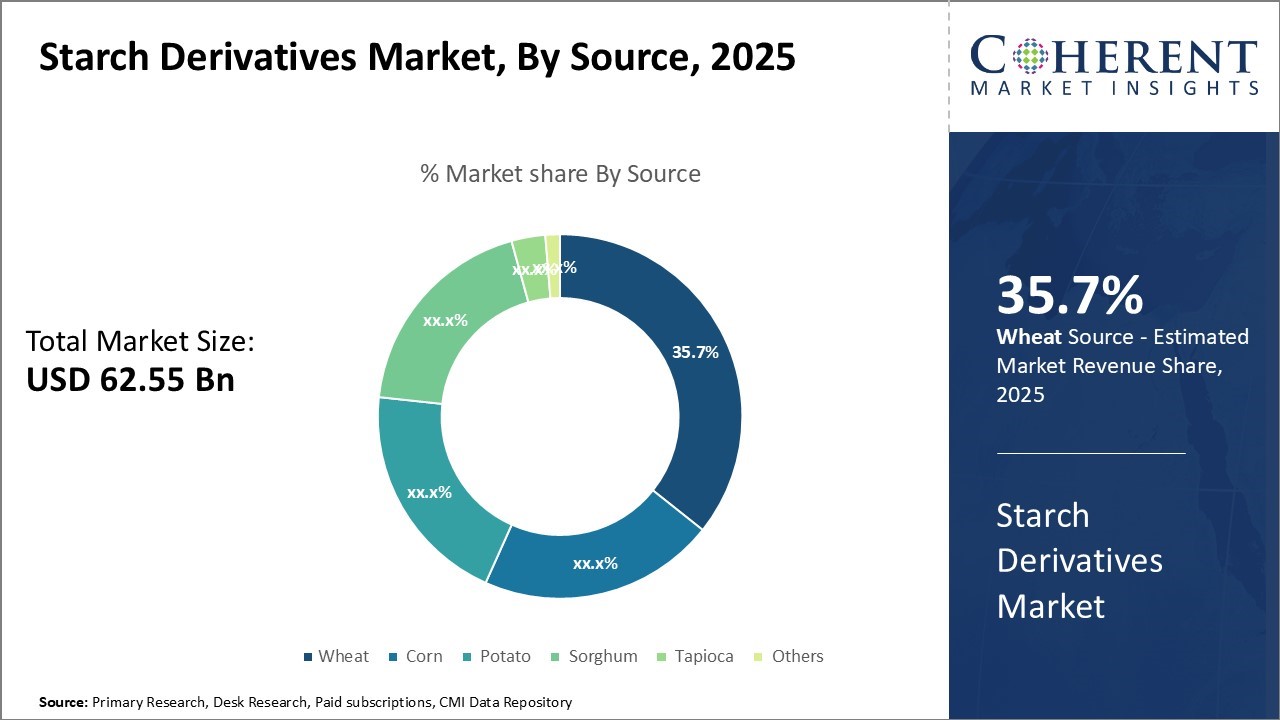Starch Derivatives Market Size and Forecast – 2025 to 2032
The starch derivatives market is estimated to be valued at USD 62.55 Bn in 2025 and is expected to reach USD 80.72 Bn by 2032, growing at a compound annual growth rate (CAGR) of 3.7% from 2025 to 2032.

To learn more about this report, Download Free Sample
Key Takeaways
- Based on Source, Tapioca segment is projected to account for 35.7% of the global market in 2025, owing to its benefits to environment and farming.
- Based on Method of Application, the Binder segment is expected to capture 38.3% share of the market in 2025, due to its usage in bonding applications.
- Based on End-User Industry, the Food and Beverage segment is projected to command 40.3% share of the market in 2025, due to rising demand for processed food.
- Based on Region, North America is set to dominate the global market with a 40. 3% share in 2025.
Market Overview
Starch derivatives have wide applications in various industries such as food & beverages, paper, textile, and pharmaceutical. The rising demand from these industries is driving the starch derivatives market growth. Increased consumption of convenience and processed food globally is projected to boost the growth of the market. Moreover, rising need for biodegradable products across industries to cater to sustainability goals will provide opportunities for manufacturers. However, volatility in raw material prices may hamper the market growth to some extent over the next few years.
Current Events and their Impact
|
Current Event |
Description and its Impact |
|
Technological Innovations in Starch Processing |
|
|
Food Industry Transformation and Health Trends |
|
Uncover macros and micros vetted on 75+ parameters: Get instant access to report
End-user Feedback and Unmet Needs in the Starch Derivatives Market
End-User Feedback in the Starch Derivatives Market
End-users across various industries—including food and beverage, pharmaceuticals, textiles, and paper manufacturing—have provided valuable feedback on starch derivatives. Many appreciate the improved functional properties such as enhanced texture, stability, and shelf life that modified starches offer.
In the food industry, for example, users commend the ability of starch derivatives like maltodextrin and modified corn starch to improve mouthfeel and act as effective fat replacers. However, there is also concern over labeling transparency and the perceived "unnaturalness" of chemically modified starches, especially among health-conscious consumers. In industrial applications, end-users have highlighted the need for more consistent quality and performance of starch derivatives in high-temperature and high-shear processes.
Unmet Needs in the Starch Derivatives Market
Despite ongoing innovation, several unmet needs persist in the starch derivatives market. One major gap is the demand for clean-label and non-GMO starch derivatives that still offer the same functionality as traditional modified starches. Manufacturers are also seeking derivatives with improved solubility, faster hydration, and greater resistance to extreme processing conditions such as high heat or acidic environments.
Furthermore, there is a growing need for biodegradable and sustainable starch-based alternatives in the packaging and plastic industries. Cost competitiveness and supply chain transparency also remain key concerns, particularly in emerging markets where access to high-quality raw materials may be limited.
Starch Derivatives Market Insights, By Source - Conducive tropical climate is driving tapioca cultivation
In terms of source, tapioca contributes 35.7% share of the starch derivatives market revenue owing to a combination of environmental and farming advantages. Tapioca, also known as cassava, originates in South America and requires a warm tropical climate to thrive. Many major producing countries such as Thailand, Nigeria, and Brazil experience long periods of warm weather year-round, ideal conditions for tapioca cultivation.
The humid tropical climate enables intensive farming of the root vegetable with minimal other inputs. Farmers can cultivate tapioca with few irrigation or pest control requirements compared to other starch sources like wheat or corn. Abundant sunshine also means higher crop yields from the same acreage of land.
In August 2024, Roquette expanded its texturising solutions with four new tapioca-based starches—CLEARAM TR 2010, TR 2510, TR 3010, and TR 4010—designed to improve the viscosity and consistency of products like sauces and dairy desserts.
Starch Derivatives Market Insights, By Method of Application - Versatility is driving binder usage
In terms of method of application, binder contributes 38.3% share of the market owing to the multi-functional uses of starch in bonding applications. Starch binders are versatile ingredients widely used in food processing, paper making, construction materials, and other industries.
As a binder, starch coats and adheres particles together through film formation. It replaces synthetic petrochemical binders in many applications due to advantages such as renewable sourcing, low cost, and biodegradability.
Starch binders effectively hold together ingredients in products ranging from snack foods to construction wallboards. Their bonding properties enable forming composite materials and coating applications across industries. Starch binders have established uses in a variety of manufacturing processes, creating demand from diverse end markets. Their functionality, compatibility with other materials and adaptability to changing production needs have made starch binders a staple binding agent.
Starch Derivatives Insights, By End-User Industry - Growth of food processing is driving the segment growth
In terms of end user Industry, the food and beverage industry contributes 40.3% share of the market owing to the rising global consumption of processed foods. Starch derivatives plays a crucial role as a food additive, improving texture, extending shelf life, and providing functional benefits. The food processing industry has experienced steady expansion globally to meet the growing worldwide demand for packaged and convenience foods.
Rising incomes and urbanization in developing markets have supported this trend. Starch helps process larger volumes of ingredients while maintaining quality and safety standards. Its use allows customizing food properties and extending ranges of product formulations.
For instance, in February 2024, Ingredion Incorporated announced NOVATION® Indulge 2940 starch, expanding their line of clean label texturizers with the first non-GMO functional native corn starch that provides a unique texture for gelling and co-texturizing for popular dairy and alternative dairy products and desserts.
Regional Insights

To learn more about this report, Download Free Sample
North America Starch Derivatives Market Analysis and Trends
North America has established itself as a dominant region in the global starch derivatives market over the years with 40.3% of the market share. The market is driven by strong demand from key end-use industries such as food and beverages, paper making, and pharmaceuticals. Countries like the U.S. and Canada have a huge food processing industry which consumes starch derivatives like glucose syrup, maltodextrin, and hydrolyzed starch on a massive scale.
The presence of leading global manufacturers in the region who have since long-established production facilities catering to local demand has further cemented North America's leadership position. Moreover, North America also has a large pharmaceutical industry that relies on native and modified starches for various applications.
Asia Pacific Starch Derivatives Market Analysis and Trends
Asia Pacific has emerged as the fastest growing regional market for starch derivatives in recent times on account of robust economic growth and rising population in countries such as China, India, and Indonesia. Rapid industrialization and urbanization have propelled the demand from construction, packaging, and various process industries.
Moreover, the food processing sector in Asia Pacific has also expanded significantly over the last decade to meet the needs of a burgeoning middle class. This has provided a significant boost to starch derivative consumption.
For instance, In March 2025, catering to the growing demand from India’s confectionery, infant formula, and dairy sectors, Cargill inaugurated a new corn starch milling plant in Gwalior, Madhya Pradesh set up by Saatvik Agro Processors, an Indian manufacturer.
Starch Derivatives Market Outlook Country-Wise
U.S. Starch Derivatives Market Trends
The U.S. starch derivatives market is witnessing steady growth, driven by rising demand across food & beverage, pharmaceutical, and industrial applications. Key trends include a strong shift toward clean-label and non-GMO ingredients, with consumers favoring recognizable terms like "corn starch" or "tapioca starch" over synthetic additives. For instance, according to an article published by U.S. Grains & Bioproducts council, there are more than 25 industrial starch plants located in the United States. This is further proliferating the starch derivatives market demand.
China Starch Derivatives Market Trends
China’s starch derivatives market is growing, driven by rising demand from food & beverage, pharmaceuticals, cosmetics, and industrial sectors. Glucose syrup dominates both in revenue and fastest growth trajectories. Key trends include a shift toward clean‑label, non‑GMO, sustainable and natural ingredients; innovation in modified starches with improved functionalities; and growing governmental support for domestic production and eco‑friendly manufacturing.
Market Report Scope
Starch Derivatives Market Report Coverage
| Report Coverage | Details | ||
|---|---|---|---|
| Base Year: | 2024 | Market Size in 2025: | USD 62.55 Bn |
| Historical Data for: | 2020 To 2024 | Forecast Period: | 2025 To 2032 |
| Forecast Period 2025 to 2032 CAGR: | 3.7% | 2032 Value Projection: | USD 80.72 Bn |
| Geographies covered: |
|
||
| Segments covered: |
|
||
| Companies covered: |
Cargill, Incorporated , ADM , Tate & Lyle PLC , Roquette freres , AGRANA Beteiligungs-AG , Ingredion Incorporated , Green Processing Corp. (GPC) , Avebe , Emsland Group , Foodchem International Corporation, Sukhjit Starch & Chemicals Ltd. , Universal Starch Chem Allied Ltd , Primient , SPAC Starch Products (India) Private Limited , JP&SB International, Matsutani Chemical Industry Co., Ltd, Crespel & Deiters Group, SMSCor. , Manildra Group, and KMC |
||
| Growth Drivers: |
|
||
| Restraints & Challenges: |
|
||
Uncover macros and micros vetted on 75+ parameters: Get instant access to report
Market Trends
Growth of the Bakery and Confectionery Industry
The bakery and confectionery industry have seen steady growth globally over the past few years. The demand for bakery and confectionery products has increased significantly across regions due to increasing consumer awareness about health and taste, rising disposable incomes, and busy lifestyles. Starch derivatives play a key role in the bakery and confectionery sector as they are used as stabilizers, thickeners, and texturizers in a wide variety of products.
Starches extracted from potatoes, maize, and wheat are the most commonly used starch derivatives in the industry. They allow for improved texture and quality in baked goods as well as make creams, lotions and other fillings easier to mix. For instance, modified starches are increasingly being used in cake mixes as they enhance moisture retention and provide volume and structure. Similarly, bakery products such as bread benefit from starch derivatives which help improve softness and freshness.
Additionally, confectionery items like chocolate, candies and chewing gums employ starch derivatives to control crystallization and delay gumming. A significant trend in recent times is the rising demand for clean label and organic products. In line with this, manufacturers are utilizing starch sources such as cassava and arrowroot more often in place of GM corn and potato starches.
Furthermore, developments in starch modification technology have significantly improved textures without compromising on taste. This allows the industry to cater to a wider variety of baked snacks and desserts.
Market Opportunities: Rising health consciousness
Rising health consciousness is driving the demand for specialized formulations with specific functional benefits. Technological advancements continue to spur new product applications in areas like textiles, paper, and pharmaceuticals. As incomes rise across the developing world, starch derivatives are poised to gain ground as affordable dietary essentials and thickening agents. With innovation and sustainable practices, companies can meet consumer needs while assuaging public concerns over social and environmental impacts.
Market Concentration and Competitive Landscape

To learn more about this report, Download Free Sample
Analyst Opinion (Expert Opinion)
- The global starch derivatives market is witnessing steady growth over the past few years. North America is considered as the dominating region during the forecast period owing to strong demand from key end-use industries such as food and beverages, paper making, and pharmaceuticals. Favorable climatic conditions and low-cost labor make Asia Pacific fastest growing region.
- Food and beverage industry accounts for the bulk of starch derivatives consumption globally. Within this segment, demand for bakery and confectionery, processed food and beverages sub-segments is surging the fastest. Growth in packaged food sector in developing nations is creating sustained pull for starch derivatives. Rapid urbanization and rising disposable income are supporting this change in dietary habits and consumption patterns.
Starch Derivatives Industry News
- In June 2025, Ingredion partnered with Austrian company Agrana to increase starch production in Romania, expanding its manufacturing presence in Eastern Europe to address the rising regional demand for specialty starches.
- In February 2025, Linqing Deneng Golden Corn Bio Limited, expanded its operations by opening two additional starch processing facilities. The company operates two cornstarch production lines at its existing facilities, with annual production capacities of 550,000 tonnes and 450,000 tonnes, respectively.
- In December 2024: Ingredion, Inc. introduced Novation Indulge 2940 starch to its clean label texturizer portfolio, featuring a non-GMO functional native corn starch. The starch provides enhanced texture capabilities for gelling and co-texturizing applications in dairy products, dairy alternatives, and desserts.
Market Segmentation
- Source Insights (Revenue, USD Bn, 2020 - 2032)
- Wheat
- Corn
- Potato
- Sorghum
- Tapioca
- Others
- Method of Application Insights (Revenue, USD Bn, 2020 - 2032)
- Binder
- Thickener and stabilizer
- Cake Mix
- Sweetener
- Lustering Agent
- Powdering agent
- Fish Culture Feed
- Expanded Feed
- Caking agent
- Shampoo
- Dehumidification Agent
- Others (Culture Medium, etc.)
- End User Industry Insights (Revenue, USD Bn, 2020 - 2032)
- Food and beverage industry
- Medical Industry
- Agricultural Industry
- Chemical Industry
- Personal Care and Hygiene Industry
- Paper and Pulp Industry
- Textile Industry
- Manufacturing Industry
- Others (Construction Industry, etc.)
- Regional Insights (Revenue, USD Bn, 2020 - 2032)
- North America
- U.S.
- Canada
- Latin America
- Brazil
- Argentina
- Mexico
- Rest of Latin America
- Europe
- Germany
- U.K.
- Spain
- France
- Italy
- Russia
- Rest of Europe
- Asia Pacific
- China
- India
- Japan
- Australia
- South Korea
- ASEAN
- Rest of Asia Pacific
- Middle East & Africa
- GCC Countries
- Israel
- Rest of Middle East & Africa
- Key Players Insights
- Cargill, Incorporated
- ADM
- Tate & Lyle PLC
- Roquette freres
- AGRANA Beteiligungs-AG
- Ingredion Incorporated
- Green Processing Corp. (GPC)
- Avebe
- Emsland Group
- Foodchem International Corporation
- Sukhjit Starch & Chemicals Ltd.
- Universal Starch Chem Allied Ltd
- Primient
- SPAC Starch Products (India) Private Limited
- JP&SB International
- Matsutani Chemical Industry Co., Ltd
- Crespel & Deiters Group
- SMSCor.
- Manildra Group
- KMC
Sources
Primary Research Interviews
- Starch derivatives manufacturers and suppliers
- Food and beverage industry executives
- Pharmaceutical and cosmetics industry professionals
- E-commerce platform managers and distributors
- Others
Databases
- Euromonitor International
- Others
Magazines
- Food Processing Magazine
- Starch/Stärke International Journal
- Nutraceuticals World
- Industrial Biotechnology Magazine
- Others
Journals
- Journal of Food Science and Technology
- Carbohydrate Polymers Journal
- International Journal of Food Properties
- Others
Newspapers
- Food Business Magazine
- Chemical & Engineering News
- Nutraingredients
- Food Navigator
- Others
Associations
- International Starch Institute (ISI)
- Corn Refiners Association (CRA)
- European Starch Industry Association (AAF)
- National Starch and Chemical Company Association
- Others
Public Domain Sources
- FDA (Food and Drug Administration) publications
- USDA (United States Department of Agriculture) reports
- European Food Safety Authority (EFSA) guidelines
- WHO (World Health Organization) food standards
- Others
Proprietary Elements
- CMI Data Analytics Tool, Proprietary CMI Existing Repository of information for last 8 years
*Definition: The starch derivatives market involves the manufacturing, processing, and sale of modified starch products derived from natural starch sources like corn, wheat, tapioca, and potato. Common starch derivatives produced include maltodextrin, glucose syrup, hydrogenated glucose syrup, sorbitol, xanthan gum, and methyl cellulose.
Share
Share
About Author
Sakshi Suryawanshi is a Research Consultant with 6 years of extensive experience in market research and consulting. She is proficient in market estimation, competitive analysis, and patent analysis. Sakshi excels in identifying market trends and evaluating competitive landscapes to provide actionable insights that drive strategic decision-making. Her expertise helps businesses navigate complex market dynamics and achieve their objectives effectively.
Missing comfort of reading report in your local language? Find your preferred language :
Transform your Strategy with Exclusive Trending Reports :
Frequently Asked Questions
EXISTING CLIENTELE
Joining thousands of companies around the world committed to making the Excellent Business Solutions.
View All Our Clients

